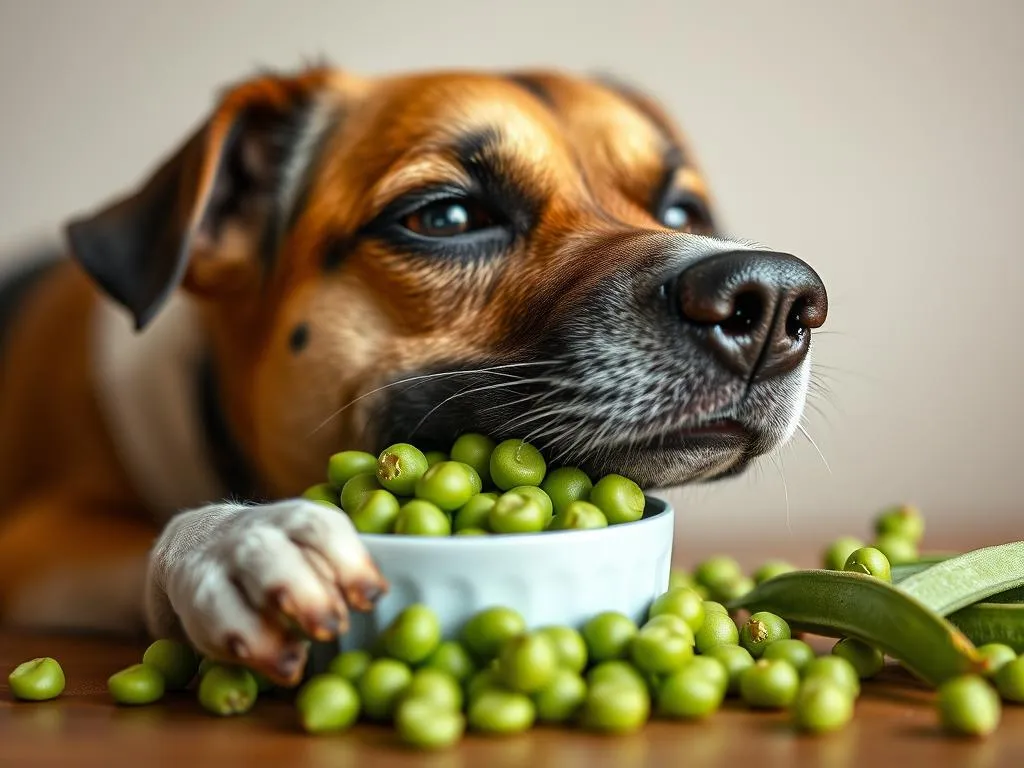
Are peas a healthy snack for your furry friend? Understanding what foods are safe for dogs is crucial for any pet owner. Peas are a common vegetable, but many dog owners may wonder whether they should include them in their dog’s diet. This article aims to provide clear information about the safety and nutritional value of peas for dogs, helping you make informed dietary choices for your canine companion.
Understanding Canine Nutrition
Importance of a Balanced Diet
A balanced diet is essential for your dog’s overall health. Just like humans, dogs require a mix of different nutrients to thrive. The primary components of a dog’s diet include:
- Proteins: Essential for growth, tissue repair, and immune function.
- Fats: Provide energy and are crucial for absorbing certain vitamins.
- Carbohydrates: Serve as a source of energy and aid in digestive health.
- Vitamins and Minerals: Vital for various biochemical processes and overall well-being.
A well-rounded diet ensures that your dog gets all the necessary nutrients for optimal health.
Role of Vegetables in a Dog’s Diet
Vegetables can play a significant role in enhancing a dog’s diet. They are a great source of vitamins, minerals, and fiber, which contribute to a dog’s overall health. Some common vegetables that are safe for dogs include:
- Carrots
- Green beans
- Sweet potatoes
- Spinach
- And, of course, peas!
Incorporating vegetables into your dog’s diet can provide a variety of health benefits while adding some excitement to their meals.
Nutritional Profile of Peas
Types of Peas Safe for Dogs
When considering whether dogs can eat peas, it’s important to know which types are safe. Here are a few varieties that are generally considered safe for dogs:
- Split peas
- Green peas
- Snow peas
- Sugar snap peas
Each type of pea offers unique nutritional benefits, making them a versatile addition to your dog’s diet.
Nutritional Benefits of Peas
Peas are packed with essential nutrients. Here’s a breakdown of their nutritional profile:
- Vitamins: Peas are rich in vitamins A, K, and several B vitamins, which support various bodily functions, including vision, bone health, and metabolism.
- Minerals: They contain important minerals like iron and magnesium, which are vital for blood health and bone development.
- Fiber Content: Peas are an excellent source of dietary fiber, which promotes healthy digestion.
- Protein Sources: While not a complete protein, peas do contain a decent amount of protein, making them a suitable addition to a dog’s diet.
The combination of these nutrients makes peas a beneficial snack for dogs.
Health Benefits of Feeding Peas to Dogs
Digestive Health
One of the primary benefits of feeding peas to dogs is their high fiber content. Fiber plays a crucial role in maintaining good digestive health by promoting regular bowel movements and preventing constipation. It can also help maintain a healthy weight by making dogs feel fuller for longer.
Weight Management
Peas are low in calories, making them an excellent option for dogs that need to maintain or lose weight. Incorporating peas into your dog’s diet can help manage obesity without sacrificing their satiety. This means you can treat your dog without the guilt of overindulging them.
Antioxidant Properties
Peas are rich in antioxidants, which help combat oxidative stress in dogs. Antioxidants can protect cells from damage caused by free radicals, potentially reducing the risk of chronic diseases. Including peas in your dog’s diet can contribute to their overall health and longevity.
Potential Risks and Considerations
Allergies and Sensitivities
While peas are generally safe for dogs, some may have allergies or sensitivities. Signs of an allergic reaction can include itching, swelling, or gastrointestinal upset. If you notice any unusual behavior after introducing peas, consult your veterinarian.
Preparation and Serving Suggestions
It’s essential to prepare peas correctly before feeding them to your dog. Here are some preparation tips:
- Cooked vs. Raw: While dogs can eat raw peas, cooking them can make them easier to digest and enhance their nutritional value. Steaming or boiling is recommended.
- Serving Sizes: The recommended serving size of peas varies based on your dog’s size and breed. A general guideline is to offer a small handful for larger dogs and a teaspoon for smaller breeds.
Toxicity Concerns
There is a misconception that certain legumes, including peas, can be toxic to dogs. However, peas themselves are safe. It’s essential to avoid feeding dogs toxic foods such as onions, garlic, and certain types of beans, which can cause severe health issues. Always ensure that any new food introduced into your dog’s diet is safe.
How to Introduce Peas into Your Dog’s Diet
Gradual Introduction
When introducing peas into your dog’s diet, it’s best to start gradually. Begin with small amounts to see how your dog reacts. This approach minimizes the risk of digestive upset.
Mixing Peas with Other Foods
Peas can be a delightful addition to your dog’s meals. Consider mixing them with other dog-safe foods, such as:
- Rice
- Sweet potatoes
- Lean meats
This variety can make your dog’s meals more enjoyable and nutritionally balanced.
Monitoring Your Dog’s Reaction
After introducing peas, keep an eye on your dog’s reaction. Watch for any signs of digestive upset, such as diarrhea or vomiting, as well as any allergic reactions. If you notice anything concerning, consult your veterinarian for advice.
Expert Opinions and Studies
Veterinarian Insights
Many veterinarians recommend incorporating healthy vegetables like peas into dogs’ diets. They emphasize the importance of variety and balanced nutrition, noting that peas can be a valuable addition due to their nutrient density.
Research Studies
Several studies have explored the benefits of including vegetables in canine diets. Research supports that vegetables, including peas, can contribute positively to a dog’s health by providing essential nutrients and promoting better digestion.
Frequently Asked Questions (FAQs)
Can all dogs eat peas?
Most dogs can eat peas without issues. However, always consult with your veterinarian, especially if your dog has a history of food allergies.
How often can I feed my dog peas?
Peas can be offered as an occasional treat or mixed into meals several times a week. Balance and moderation are key.
Are frozen peas safe for dogs?
Yes, frozen peas are safe for dogs. Just ensure they are plain and unseasoned. Thaw them before serving to make them easier to chew.
Can peas cause gas in dogs?
Some dogs may experience gas after consuming peas due to their fiber content. If your dog shows signs of discomfort, consider reducing the amount you feed them.
Conclusion
In summary, dogs can eat peas, and they can be a healthy addition to your dog’s diet. The benefits of feeding peas include improved digestive health, weight management, and antioxidant properties. However, always consider potential risks, such as allergies, and consult your veterinarian before making significant dietary changes for your pet.
Incorporating peas into your dog’s meals can provide them with essential nutrients while keeping their diet varied and exciting. Have you tried feeding your dog peas? Share your experiences in the comments!






